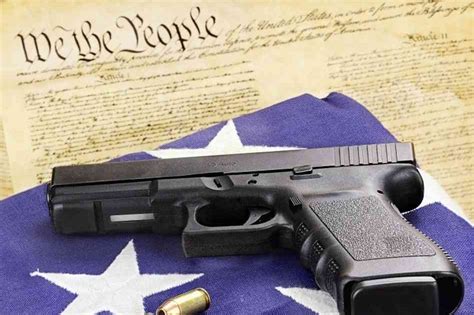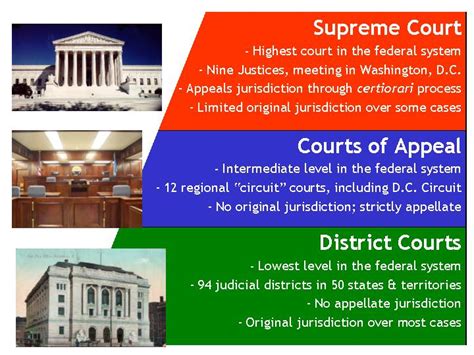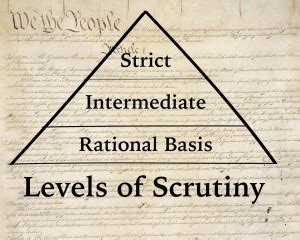 Basic orientation for
2nd Amendment advocates
Basic orientation for
2nd Amendment advocates(Disclaimer: I’m not a lawyer and nothing that follows is legal advice.)
(2021-01-25) First, everything here describes the way things are now. They are not as most of us wish they were. They are probably not the way the founders would want. However, this is the reality we must live with.
Before we talk about scrutiny, let’s review how the federal courts are structured:
 District
Courts – The lowest level of the federal court system, this is where
the actual trials on the merits take place.
District
Courts – The lowest level of the federal court system, this is where
the actual trials on the merits take place.Circuit Courts of Appeals (3 Judge Panels) – Decisions of the District Courts are first appealed to these panels. Decisions of the Circuit Courts set “case law” for the area they serve – unless there is a conflicting SCOTUS decision. Thus if two or more of these courts decide cases differently, it is possible for Americans to have a right in some states, but not in others. This is exactly the case with the right to carry outside the home.
Circuit Courts of Appeals (En Banc Panels) – If a litigant is dissatisfied with the decision of the 3 Judge Panel, this is where they can appeal. In most Districts, this means that all of the Judges of that Circuit hear the case. The exception is the huge 9th Circuit, where panel of 8-12 Judges hears the appeal.
Supreme Court of the United States (SCOTUS) – The final appeal is to the highest court in the land. Decisions of the Court are binding upon all states and territories of the United States. SCOTUS only takes a few (80-100) out of the thousands of cases appealed to it each year. Typically, they look for issues where there is a conflict between appeals courts.
Levels of Scrutiny
 SCOTUS
and all lower courts handle cases involving legal and constitutional
rights by applying one of three tests.
SCOTUS
and all lower courts handle cases involving legal and constitutional
rights by applying one of three tests.Rational Basis Test:
The lowest level of scrutiny, this review tests whether the government's actions are:
(1) "rationally related" to a
(2) "legitimate" government interest.
No one argues that this is the appropriate test for 2nd Amendment cases, not even gun control groups.
Intermediate Scrutiny:
In order to overcome the intermediate scrutiny test, the government must show that:
(1) the law or policy being challenged furthers an important government interest by
(2) means that are substantially related to that interest.
Gun control groups argue that this is the test that should be used in 2nd Amendment cases. However, gun rights groups have won many cases even when this level of scrutiny was applied.
Strict Scrutiny:
The highest standard, this is the standard of review we want.
The strict scrutiny standard is applied in when a fundamental constitutional right is infringed, particularly those found in the Bill of Rights and a fundamental right protected by the Due Process Clause or "liberty clause" of the 14th Amendment, or when a government action applies to a "suspect classification", such as race or national origin. Given that the 2nd Amendment is part of the Bill of Rights, it seems clear that this is the standard that should apply – but we will need a SCOTUS ruling to mandate this.
This standard of review requires the government to prove that the law or regulation passes a two fold test:
1) The law or regulation is necessary to achieve a "compelling state interest". This is a very difficult test. Consider the definition of the word "compel": "To force (a person) to do something; drive or constrain, to necessitate or require, as by force of circumstance; demand, to exert a strong, irresistible force on; sway." Therefore, a compelling interest is one in which government is forced to act by the circumstances. The vast majority of gun laws would fail this test. If they do, then that is the end of the case and we win.
AND
2) The law is "narrowly tailored" to achieve the compelling purpose, and uses the "least restrictive means" to achieve the purpose. Even if the law passes the first test, that does not give government the ability to regulate the right out of existence. In fact, the law is still presumptively unconstitutional. In order to pass this test, government must prove that there is no other less restrictive and intrusive way to achieve the compelling purpose. Since most gun laws are designed to be as intrusive and restrictive as possible, they fail this test.
At some point, involving a 2nd Amendment case, SCOTUS will decide what the standard of review for the 2A is to be. If we were to get strict scrutiny, what would be the result?
1) Most gun laws would become unconstitutional. They would still have to be challenged, but winning cases and getting them struck down would be much easier.
2) Even those laws that would survive would be radically changed for the better.
A Real World Example:
Let’s consider the probable impact on purchasing gun in California. Currently, buying a gun in California involves going through a state background check system, including registration of the firearm, a ten day waiting period (just because), presenting multiple proof of address documents, passing a test and obtaining a Firearms Safety Certificate, and demonstrating proper operation of the firearm. All of this in addition to the federal requirement for a NICS check.
Let’s assume (just for the moment) that SCOTUS decides that there is a compelling interest in keeping felons and the severely mentally ill from obtaining firearms and that NICS checks are the least intrusive method of accomplishing this. This would be viewed by most as lost for gun rights – but that doesn’t mean we cannot use it….
We then could challenge the entire California system as an unnecessary infringement. If the federal government has already met the compelling need with its’ background check system, the entire state system is then redundant and therefore unconstitutional. California would then have to prove that their system still meets a compelling need that the federal NICS system doesn’t meet. To do that, they would have show that California’s burdensome system is actually making California safer than the many other states that only have the NICS system. That would likely be an impossible task – so California would lose and their entire system would go away.
Of course, if SCOTUS were to find the NICS system unconstitutional, the California system would be unconstitutional as well.
This is but one example the impact of Strict Scrutiny. If the Justices decide that strict scrutiny applies to the 2A, the worst gun laws would go away – and that would be a very good thing.
Now that we have looked at how the federal courts work and the important issue of scrutiny, we are ready to look at some current cases and issues. We will begin in the next article, with the issue of carry outside the home.









